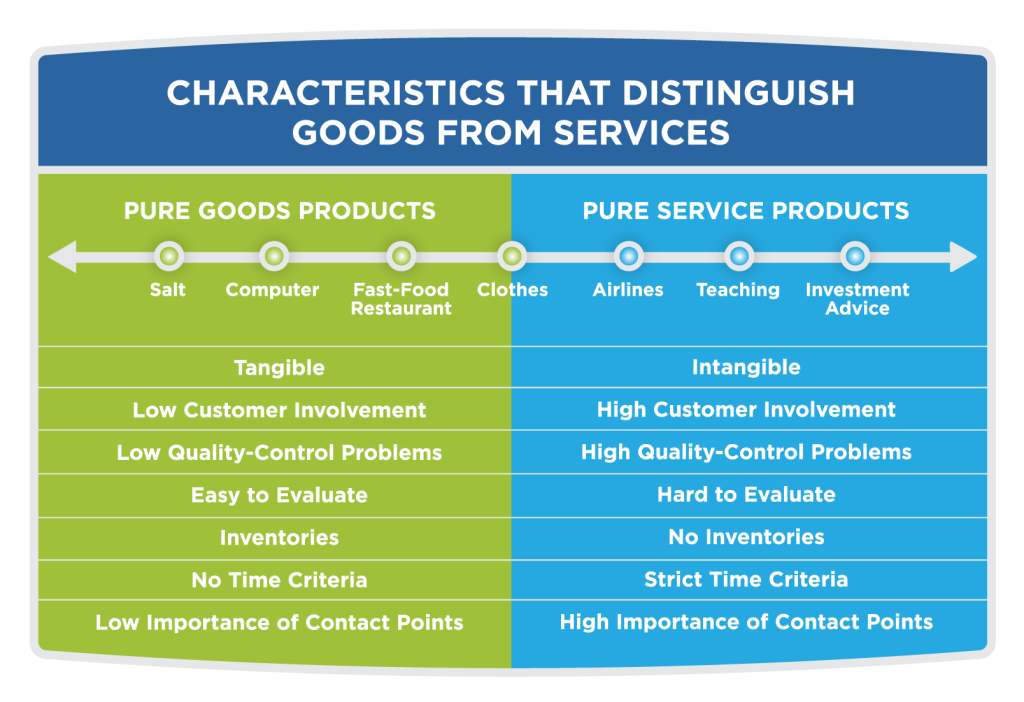Learning Objectives
- Identify differences between products that offer goods versus services
Goods vs. Services
In marketing, are services considered products? Should products that are predominately goods be treated differently than products that are predominantly services? Whether or not there are substantial differences between goods, products, and service products has been the source of great debate in marketing. Opponents of the division assert that “products are products,” and just because there are some characteristics associated with service products and not goods products and vice versa, it doesn’t mean that customized strategies are necessary for each. Advocates on the other side offer evidence that the differences are significant indeed.
You may have noticed that throughout this course we use the term “product” broadly to address the full product offering that is comprised of goods, services, and often a combination of both. We’ve given examples of service products (hotel stays, for instance) and goods products (sneakers and bread, for instance). Thinking inclusively about the tangible and intangible aspects of all products is useful because it creates a more complete view of the customer’s product needs and experience. Still, there are unique characteristics of services that set them apart from goods. It is important to understand the differences and to consider them in the development of strategies, tactics, and objectives.
Service products are reflected by a wide variety of industries: utilities, restaurants, educational institutions, consulting firms, hotels, medical care providers, and banking, to name but a few. Beyond these traditional industries there is a growing sector of software as a service offered by companies that provide individuals and other companies with hosted and managed access to software systems. In 2013, software as a service was a $22.6 billion industry, and by 2018 it is projected to be $50.8 billion[1]. Services account for nearly 50 percent of the average consumer’s total expenditures, 70 percent of the jobs, and two-thirds of the U.S. Gross National Product (GNP). Clearly, the service sector is large and is growing. While all products share certain common facets, service products tend to differ from goods products in a number of ways.
Characteristics of Service Products
As you can see from the examples above, service products are quite diverse. Nonetheless, they tend to have the following characteristics.
Intangible
Leonard Berry offers this useful differentiation: “A good is an object, a device, a thing; a service is a deed, a performance, an effort.”[2]With the purchase of a good, you have something tangible—an item that can be seen, touched, tasted, worn, or displayed. That’s not true of a service, which is intangible (quite literally, “not able to be touched”).
Although you pay your money and consume the service, there is nothing tangible to show for it. For example, if you attend a professional football game, you spend money for a ticket and spend nearly three hours taking in the entertainment. After the game, you leave. Unless you have purchased a good at the game, you will not take anything tangible to take away (except, perhaps, the ticket stub).
Simultaneous Production and Consumption
Service products are consumed at the same time they are being produced. The tourist attraction is producing entertainment or pleasure at the same time it is being consumed. In contrast, goods products are produced, stored, and then consumed. A result of this characteristic is that the provider of the service is often present when consumption takes place. Dentists, hotel staff, hair stylists, and ballet dancers are all present when the product is used.
Little Standardization
Because service products are so closely related to the people providing the service, ensuring the same level of satisfaction every time is very difficult. Dentists have their bad days, not every baseball game is exciting, and the second vacation to Walt Disney World Resort may not be as wonderful as the first.
High Buyer Involvement
With many service products, the purchaser may provide a great deal of input into the final form of the product. For example, if you wanted to go on a Caribbean cruise, you would visit a number of Web sites describing the various cruise locations, review the available options for cabin location and size, islands visited, food, entertainment, prices, and whether they accommodate children. Although the task would be very time consuming, you could, if you wanted, practically design every moment of your vacation.
It should be noted that the four characteristics associated with service products described above vary in intensity from product to product. In fact, service products are best treated as existing on a continuum, shown in the following figure.
When marketing a service, it’s important to remember that (a) service products on the right side of the continuum (i.e., those with greater intangibility) are different from goods products on the left side of the continuum, and (b) service products tend to require certain adjustments in their marketing strategy on account of these differences.
All products, whether they are goods, services, blankets, diapers, or plate glass, possess peculiarities that require adjustments in the marketing effort. However, “pure” goods products and “pure” service products (i.e. those on the extreme ends of the continuum) tend to reflect characteristics and responses from customers that suggest different marketing strategies. Admittedly, offering an exceptional product at the right price, through the most accessible channels, promoted extensively and accurately, should work for any type of product. The goods/services classification provides the same useful insights provided by the B2B/B2C classification discussed earlier.
- http://www.forbes.com/sites/louiscolumbus/2014/12/20/idc-predicts-saas-enterprise-applications-will-be-a-50-8b-market-by-2018/ ↵
- Leonard L. Berry, "Services Marketing Is Different," Business May/June 1980: 24–29. ↵


